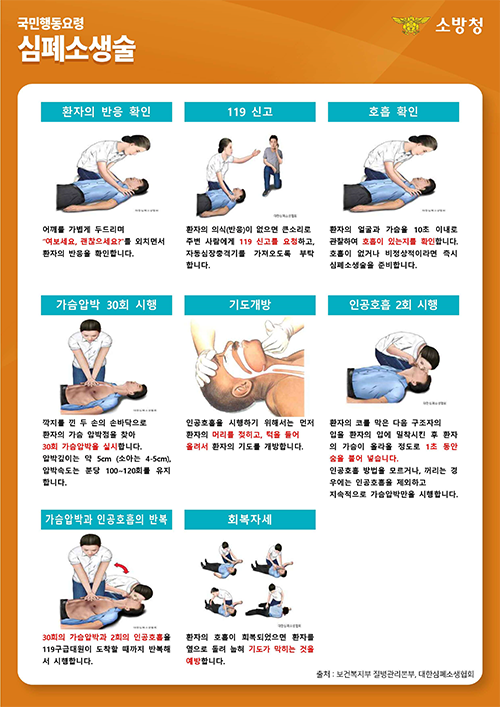 This is the order of CPR. /Photography extracted from Korean Cardiopulmonary Resuscitation Association |
Last month, there was a tragic accident that took the lives of many people in a large-scale crushing disaster. Major foreign media, including the New York Times and the Washington Post, reported the Itaewon disaster as an emergency article, pointing out that the authorities lacked measures to prevent accidents in the disaster. In addition to the crowded event, there is a high risk of crushing accidents due to large crowds such as subways and escalators on the way to and from work. Thus, the Dongguk Post is going to find out how to cope with a crush accident.
First, death due to no-breathing because of pressure is called traumatic asphyxiation. In situations where it is difficult to breathe due to crowds, you should first secure a safety distance. Raise your arms with your arms crossed and leave at least 15-centimeter of space in front of your chest to ensure a minimum breathing environment. This posture can withstand pressure pushed back and forth and secure the range of motion of the diaphragm and ribs required for inhalation. If you cannot cross your arms, you should put a fluffy object on your chest to prevent direct pressure. In this state, it is recommended to move diagonally while holding out your legs apart on both sides. However, if you have already fallen behind the crowd, you would better take a “fetal posture,” where you wrap your head and pull your legs as close to your body as possible. This is to protect organs and lungs and to secure a space to breathe. Experts say that crush accidents usually have premonitory symptoms. According to the testimony of survivors of the Itaewon disaster, they had already been swept away by the crowd since 8 P.M., two hours before the incident.
In the Itaewon disaster, many cardiac arrest patients occurred at the same time, and there was a lack of rescue. In this reason, ordinary people who could do cardiopulmonary resuscitation (CPR) tried to help. However, there were many people who did not know the exact method or could not help them in case they did CPR in the wrong way. Therefore, it is necessary to learn CPR methods in advance and perform them immediately in the event of an accident. In the case of suffocation patients, it is important to perform CPR quickly. CPR is a first aid method that artificially maintains breathing and maintains blood circulation when breathing or heartbeat stops. According to the National Action Guidelines provided by the Ministry of Public Administration and Security, CPR is performed in the following order .
1)Patient’s response2)119 report3)Breathing check4)Chest compression 30 times5)Respiration open6)Two artificial respirations7)Chest compression and repetition of artificial respiration8)Recovery posture
When compressing the chest, the patient’s chest should be strongly pressed at a depth of five to six centimeter at a speed of 100 to 120 times per minute. It is appropriate to compress 1/2 point below the patient’s breastbone with the palms of two hands that are folded. If you learn CPR that anyone can do in advance, it can be helpful at the scene of the accident.
We must listen to safety issues again due to the crushing disaster that killed many people. Since safety is not necessarily solely responsible for the government, citizens need to pay attention to it differently. Therefore, the Dongguk Post would like reommend to read and learn how to cope with an accident and how to perform CPR.

